|
In a true Montessori
classroom, the child’s dignity and independence are of paramount importance.
The teachers in a Montessori school should be calm and unhurried moving around
the room discreetly and quietly. They should be responsive to the needs of the
children. Children should not have to wait until they become bored or upset
before they get attention.
Montessori is a joyous
way of teaching. There is no need for shouting or anger. The teachers are
pleasant and polite when communicating with the children. All children are
shown respect, and never humiliated or laughed at. Individual lessons allow the
teachers to learn more about each child’s individuality, pace, academic and
social/emotional levels through this method.
Groups are also formed to
help children follow directions, and to participate. Although some children
will work in small groups, or with a teacher, you will see many children working
alone on classroom materials. Maria Montessori believed that two and a half to
three hours were necessary for the child’s “work cycle”. Between the ages of
three to six, it is a period of self directed activity, when concentration is at
its peak. This is why we have chosen a 3 hour session in our school, rather
than an all day program or daycare. There should be a general atmosphere of
children doing things for themselves, carefully and competently. The most
important quality of a good Montessori school is that it is a place where your
child feels stimulated, safe, and at peace.
In our classrooms the environment provides each child the introduction to the following areas.
Practical Life:
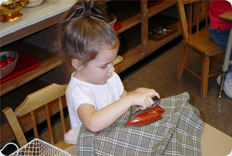 There are four distinct
groups of practical life exercises:
There are four distinct
groups of practical life exercises:
· Care
of Person
· Care
of Environment
· Development
of Social Relations
· Movement
Practical life in our classroom gives the children the freedom to care for
themselves and their environment. They practice dressing skills on frames,
which allow them to try zippers, buttons, bows, buckles, and Velcro. They use
pitchers filled with grains or water to practice pouring. The children spoon,
scoop, or use droppers, tweezers and chopsticks to transfer objects from one
bowl to another. The materials are specifically placed in order of difficulty
from left to right on the shelves and within them selves the water and object is
transferred from left to right simulating beginning reading and writing skills.
Small working tools are used (brooms, mops, dustpans, etc.) for cleaning.
Setting the table, polishing mirrors, plant watering and cleaning, folding
clothes, etc. are among the purposeful activities the children enjoy. This area
in the classroom naturally builds with the child his/her confidence and
competence. It becomes what Dr. Montessori called “help for life”. The added
purpose is that children, who work on real tasks involving the hand and mind,
develop a great capacity for concentration, which is the best preparation for
intellectual work to come.
Sensorial: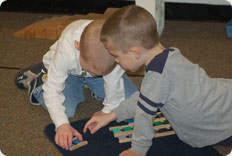
On the sensorial shelves,
there are specially designed materials to encourage development of the senses,
such as a tower of pink blocks, sets of cylinders graduated in size, cylinders
with knobs that have to be fitted into the right holes in a block. Rough and
smooth boards, smelling bottles, fabrics to sort by touch. Binomial and
trinomial cubes provide initial interest and later turn into a physical
illustration of mathematical formulas. Geometric forms called “Geometric
Solids” allow children to explore with their hands without looking. There are
many other activities that enhance the senses. These are presented to the child
in an exact way to aid their development. The sensorial materials are also used
to prepare the child for reading and writing. Some materials like the cylinders
or geometric insets are held by little knobs, which prepare the muscles of the
hand for writing. Others prepare the ear for learning differences in sounds,
distinguishing between letter sounds (phonics). If each step is taught by
itself, one step at a time, the child will gradually, almost effortlessly,
emerge into a competent reader and writer. This happens easily and joyfully
through the active manipulation of these wonderful materials.
Cultural Subjects:
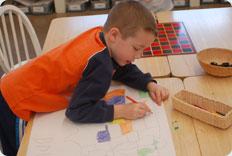 Children
begin with globes and then study maps using puzzles. They can trace and color
the shapes of the continents, and also place them in the right area on the
puzzles. They go on to name continent shapes and put them into blank maps of
the world, and also recognize and make flags. Looking at countries
individually, they will use picture cards of mothers and babies, families and
daily lives, and handle and examine things from other countries, for example, a
fan from Japan, an African drum, or ethnic dolls. The landforms teach
geographical features. Children may make trees, leaves, flowers and label their
parts. There are classification cards for naming, matching or identifying leaf
shapes, etc. Children
begin with globes and then study maps using puzzles. They can trace and color
the shapes of the continents, and also place them in the right area on the
puzzles. They go on to name continent shapes and put them into blank maps of
the world, and also recognize and make flags. Looking at countries
individually, they will use picture cards of mothers and babies, families and
daily lives, and handle and examine things from other countries, for example, a
fan from Japan, an African drum, or ethnic dolls. The landforms teach
geographical features. Children may make trees, leaves, flowers and label their
parts. There are classification cards for naming, matching or identifying leaf
shapes, etc.
Multicultural Activities:
We
have teachers that are from countries other than the U.S. and share their
culture with the children in food, song, clothing and stories. The children at
Edmonds Montessori
also
exemplify a diverse mix of ethnic and cultural groups. We celebrate our
diversity!
Math: from Concrete to Abstract
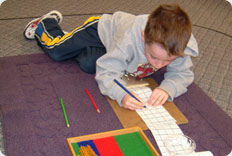
Children gain a physical
impression of size and quantity long before they begin to manipulate numbers by
handling number rods, counting beads, counting spindles into boxes, and
arranging colored counters in patterns (odd and even numbers). Numbers are
built using glass beads and a variety
or
counters. Sandpaper symbols are traced with the fingers. The children gain an
understanding of quantities, sequences, and the symbols of mathematics. They are
introduced to measuring volume (teaspoon, table spoon, ¼ cup, ½ cup, 1 cup,
quart and gallon). Recognizing numerals from 1 to 100, counting backwards, and
simple addition using objects are also introduced. Starting a number roll and
the fair exchange game helps children learn how to carry over using the Golden
Beads – base 10 system (units, tens, hundreds and thousands).
Language: from Spoken to Written
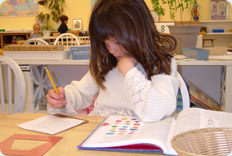 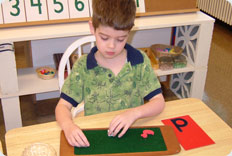
Writing often comes
before reading in a Montessori classroom. Writing skills are learned by
coloring intricate shapes with metal insets, and sandpaper letters are
experienced by touch as well as by sight and sound. Children are able to
use pencils, crayons, and markers in a variety of activities. The reading
program progresses through three levels; pink, blue, and green. Reading
materials are color-coded for each level. For example, inside a small pink
box, a child finds a tiny toy dog. She takes the dog out, says the word,
listens to the sounds in the word, and then seeks out the letters that make
those sounds to build the word. Children learn to read and write phrases,
sentences and stories. Books are always available for the children to look
at, read, and even make.
Edmonds Montessori
provides Japanese as a foreign language. This is directed by Michie
Onoyama
and is offered one day a week for one half hour session during regular class
time. Additional information is available on our website as well as a
monthly newsletter.
Art and Music:
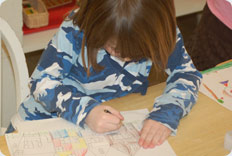
Pasting, cutting,
drawing, and painting are available freely in our classrooms. Occasionally
group craft activities planned by the teacher will occur. It is rare to see the
whole class doing a project at the same time. Throughout the year, music is
introduced during circle time. The teachers often sing songs that involve
eye/hand coordination. An introduction to rhythm sticks, maracas, triangles,
castanets, cow bell and others are also presented. Occasionally, background
music from composers is played.
Social Skills:
In class the teachers
demonstrate how to move quietly and carefully around the classroom. The
children learn how to tuck in a chair, how to roll up their floor rugs, how to
wait patiently before politely gaining someone’s attention, and are reminded how
important it is to allow others to work undisturbed. These ground rules in the
classroom build confidence and establish a sense of belonging to our group.
Children also learn to notice if somebody needs help and that nobody is too
small to be useful. We call these “grace and courtesy” exercises.
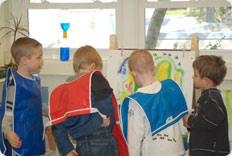
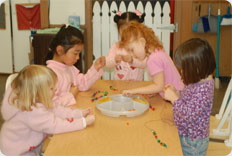
|
 There are four distinct
groups of practical life exercises:
There are four distinct
groups of practical life exercises:








